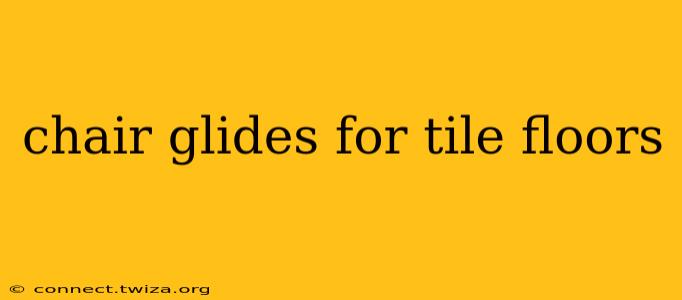Tile floors are beautiful, but they can be tough on chair legs. Scratches, scuffs, and that annoying scraping sound are common complaints. Fortunately, chair glides offer a simple and effective solution. This guide will explore everything you need to know about choosing and using chair glides for your tile floors, ensuring your chairs glide smoothly and your floors stay protected.
What are Chair Glides?
Chair glides are small, protective pads affixed to the bottom of chair legs to prevent scratching and reduce noise when moving furniture across hard floors like tile. They come in various materials, shapes, and sizes, each suited to different floor types and chair leg designs. Choosing the right ones is crucial for optimal performance and floor protection.
What Types of Chair Glides Work Best on Tile Floors?
The best chair glides for tile floors are those made from soft, non-marring materials that won't scratch the surface. Here are some popular options:
-
Felt Glides: These are a popular and affordable choice. Felt is soft enough to protect tile but durable enough to withstand regular use. However, they may wear out faster than other materials on high-traffic areas.
-
Silicone Glides: Silicone glides are exceptionally smooth and durable, offering excellent protection against scratches and providing near-silent movement. They're a great long-term investment.
-
Plastic Glides (Hard): While some plastic glides can scratch tile, those made from softer plastics like nylon or polyethylene can be suitable, especially if they have a felt or rubber backing. Always check for a "non-marring" designation.
-
Rubber Glides: Rubber glides offer good protection and durability, but some types might leave marks on certain tile finishes. Look for glides specifically designed for hard floors.
How to Choose the Right Size and Shape of Chair Glide?
Choosing the correct size and shape is essential for proper adhesion and effective protection. Measure your chair legs carefully and select glides that match the diameter or fit snugly within the leg's base. Shapes generally include round, square, and rectangular, to match various chair leg designs.
How Do I Install Chair Glides?
Installation is typically straightforward. Most glides come with self-adhesive backing. Simply clean the chair legs thoroughly with rubbing alcohol to remove any dirt or grime, peel off the protective backing, and firmly press the glide onto the leg. Ensure even pressure for optimal adhesion. For heavier chairs or if you're concerned about longevity, you may consider using additional adhesive.
What if My Chair Legs are Unconventional?
For chairs with unusual leg shapes or sizes, you might need to get creative. You could:
-
Use furniture felt pads: These larger pads offer more surface area for protection and are available in various shapes and sizes.
-
Consider custom-cut glides: Some retailers offer custom-cut felt or rubber glides to fit specific chair leg dimensions.
Will Chair Glides Prevent All Scratches on Tile Floors?
While chair glides significantly reduce the risk of scratching, they don't offer 100% protection. Factors like the weight of the chair, the type of tile, and the frequency of movement can still influence the outcome. However, they provide a substantial level of protection and are a worthwhile investment for preserving your tile floors.
How Often Should I Replace Chair Glides?
The lifespan of chair glides varies depending on their material, frequency of use, and the weight of the chair. Regularly inspect the glides for wear and tear. If they appear worn, cracked, or no longer provide smooth movement, it's time to replace them.
Are there other ways to protect my tile floors from chair scratches?
Beyond chair glides, consider using area rugs under chairs in high-traffic areas or using protective floor mats.
Conclusion
Choosing the right chair glides can make a world of difference in protecting your tile floors and ensuring your chairs move silently and smoothly. By following these guidelines and selecting the appropriate material, size, and shape, you can enjoy the beauty of your tile floors for years to come without the worry of scratches and scuffs.
